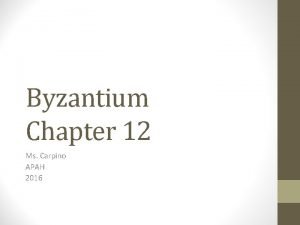RADIOACTIVITY IN VIRGIN SOILS AND SOILS FROM SOME

- Slides: 1

RADIOACTIVITY IN VIRGIN SOILS AND SOILS FROM SOME AREAS WITH CLOSED URANIUM MINING FACILITIES IN BULGARIA Ivanka Yordanova, Lidia Misheva, Martin Banov, Donka Staneva, Tsvetanka Bineva Institute of Soil Science, agro technology and plant protections “N. Poushkarov” Shousse Bankya Str. , 1080 Sifia, Bulgaria e-mail: ivanka. yordanova@gmail. com The soil radioecology is an important part of the environmental research in the country. Since the beginning of the 1970's regular monitoring of the content of different radionuclides in Bulgarian soils has been done. Objective of the studies were virgin soils from high mountain areas, hills and plains (the region of Kozloduy NPP and the Danube river valley). Natural and men-made radionuclides were observed. In the 25 -year period after the contamination with radionuclides due to the 1986 Chernobyl NPP accident a rich data base has been collected, recording the radiation status of the soils in Bulgaria. Special attention has been paid to the contamination with the long-lived technogenic radionuclides caesium-137 and strontium-90. This paper presents a summary of the obtained results. Caesium-137 and strontium-90 were the main men-made radionuclides detected in the examined Bulgarian soils few years after the Chernobyl NPP accident. Their content in the soils from high mountain areas (Rodopa and Rila mountains) is several times higher than that in the soils from North Bulgaria and Sofia fields. High non-homogenity in the pollution within small areas (even as small as several square meters) has been observed. Natural radioactivity was also studied. Averaged values for natural radionuclides like uranium-238, thorium-232, and radium-226 in virgin soils from different areas in the country are presented. A comparison of the dynamics of their behavior throughout the years is done. Bulgaria is a country with intensive uranium mining activities in the past years. That is why radiological monitoring of closed uranium mining facilities in different regions of the country are obligatory and of great interest. This work presents results from such investigations made in regions where remediation has been done. The results have been evaluated according to the Bulgarian radionuclide environment contamination legislation. The necessity of permanent environmental monitoring is assessed. I. Contamination with men-made radionuclide Besides the data for 1985 and 1986, results for the period after are also presented. Cs and Sr activity is calculated to reference date 1986 in order to discount the decay effect when studying the dynamics of the technogenic radioactive pollution of soils. The number of samples for each group from which the average values were calculated were as specified above in “Materials and methods. While summering the data and calculating the average values high nonhomogeneity was ascertained. The variances were between 20% and 80% for Strontium-90 and between 30% and 70% for Cesium-137 in the different years and different groups. Considering this we may state that there are no statistically significant changes during the years after the Chernobyl’s accident. The surface layer soil radioactivity concerning the men-made radionuclide is not affected by migration processes down the soil profile. The migration processes are discussed in other publications Fig. 1. Averaged values for 137 Cs activity in soil samples from different regions [Bq. kg-1] (1985 – 2010) II. Natural radioactivity Fig. 3. 238 U activity concentration in soil samples From different regions (1996 -2010) Fig. 4. 226 Ra activity concentration in soil samples from different regions(1996 -2010) The concentration of 238 U, 232 Th and 226 Ra as long-lived natural radionuclide's of significance in the soil will be discussed in this paper. Summary of the data obtained for the period (1996 -2010) is presented on figures 3, 4 and 5. Here again averaged values are calculated for the same groups of samples described above. The registered concentration of 238 U , 232 Th in the soils of North Bulgaria are in good agreement with the value of 40 Bq. kg-1 estimated as average concentration of these radionuclide's in soil in UNSCEAR, 1993 report. Activity concentrations of 226 Ra are also in the range of values stated in the same report. The slightly higher concentrations in soils from South Bulgaria and the of Mesta river valley are also logical as the soils in these areas are on rocks containing shale, gneiss with higher concentration of natural radioactivity Especially large disturbances and changes in the landscape and soil layer at the site are caused by the geo-technological method for extraction of uranium - on one hand the integrity of the soil is mechanically disturbed during the course of drilling and blasting, the construction of the sorption system, the deployment of drilling pipes and other technological equipment and on the other hand - the soils are subject to the chemical effects of the solutions used during the mining process. These changes and disturbances in the environmental components require precise and proper planning of the reclamation and restoration activities, combined with the recommended activities for usage of the damaged land. This is a complex and lengthy process that begins with a detailed survey of the area affected by mining works. We have studied some of the objects with former uranium mining facilities. The sampling included virgin soils and soils disturbed by the mining process activities. Information about the results obtained from 3 such areas is presented on figures 6. On fig. 6 (B) Beli iskar is included as an example of a virgin soil from a mountain region (Rila mountain) with high natural activity concentration (238 U – 650 Bq. kg-1; 226 Ra 80 Bq. kg-1) and ratio 226 Ra/238 U ≈ 8. This disequilibrium is most probably caused by the high amount of organic matter in this soil that makes relatively stable compounds with uranium. A (disturbed soils) B (virgin soils) Fig. 6. 238 U and 226 Ra concentrations in disturbed (A) and virgin (B) soils from areas with former uranium mining facilities [Bq. kg-1]. Fig. 2. Averaged values for 90 Sr activity in soil samples from different regions [Bq. kg-1] (1985 – 2010) Fig. 5. Content of 232 Th activity concentration in soil from different regions (1996 -2010) CONCLUSIONS Caesium-137 and Strontium-90 are the main radionuclides of significance, characterizing the soil pollution with man-made radionuclides in all the areas investigated as part of this study and originate from the Chernobyl accident; Natural radioactivity concentrations in the investigated virgin soil are in good agreement with the values presented in the UNSCEAR reports for different soil types in the Nordic countries; The isotope ratio 226 Ra/238 U may be used for specifying the origin of higher natural activity concentrations in soils; The appropriate measures chosen for soil fertility remediation have prevented additional pollution and human exposure in the observed areas with former uranium mining facilities.

